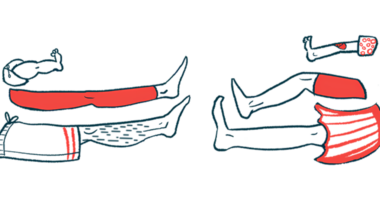At-home Device Helps in Detecting, Treating Blood Pressure Drops: Study

A real-time, home-monitoring system allowed for remote detection and management of orthostatic hypotension — a sudden drop in blood pressure when changing positions — in people with Parkinson’s disease during the COVID-19 pandemic, a pilot study shows.
Notably, the eight patients involved reported these episodes profoundly affect daily life activities and expressed high satisfaction with the home-monitoring system.
These early findings suggest this remote system may be useful in promptly identifying orthostatic hypotension in Parkinson’s patients so it can be quickly addressed, avoiding potential complications and hospital admissions.
The study, “Comprehensive telemedicine solution for remote monitoring of Parkinson’s disease patients with orthostatic hypotension during COVID-19 pandemic,” was published in the journal Neurological Sciences.
“Among non-motor features of Parkinson’s disease (PD), orthostatic hypotension (OH) represents a frequent yet overlooked phenomenon, showing a prevalence of 30–60% in [Parkinson’s patients],” the researchers wrote.
Orthostatic hypotension is characterized by the body’s inability to maintain adequate blood pressure and flow to the brain when a person stands from a sitting position, resulting in dizziness, lightheadedness, fatigue, and blurred vision. This increases the risk of falls and emergency room admission for head trauma and fractures.
It is defined by a blood pressure drop greater than 20 millimeter of mercury (mmHg) of systolic blood pressure and/or 10 mmHg of diastolic blood pressure within three minutes of standing up.
Of note, systolic blood pressure is the pressure in the arteries when the heart beats and fills them with blood, while diastolic blood pressure is the pressure in the arteries when the heart rests between beats.
Heart rate should normally show an increase of four to six beats per minute upon standing, with a greater increase in the case of orthostatic hypotension. However, this response is impaired in people with problems in the autonomic nervous system, which are often associated with an underlying neurodegenerative disorder such as Parkinson’s.
The autonomic nervous system controls involuntary actions such as digestion and heartbeat.
As such, blood pressure monitoring systems “can be extremely useful in the assessment of OH in Parkinson’s disease, in order to better evaluate the correlation between symptoms and blood pressure and to identify potentially dangerous” blood pressure drops that do not cause symptoms (are asymptomatic), the researchers wrote.
Worldwide, remote patient monitoring has gained in interest since the COVID-19 pandemic, which has restricted people’s contacts and limited hospital visits.
A team of researchers at the University of Trieste, in Italy, evaluated the feasibility of using a real-time, remote home-monitoring system and protocol to detect and manage orthostatic hypotension in Parkinson’s patients during the pandemic.
The study included eight patients (five men and three women) recruited at a single center between June and July 2020. Their mean age was 77.9, and they had been living with the disease for a mean of eight years.
They had experienced orthostatic hypotension symptoms for a mean of four years, and six patients had been formally diagnosed with orthostatic hypotension. Three also had higher-than-normal blood pressure.
For five days, patients’ blood pressure, blood-oxygen levels, heart rate, and temperature were acquired by non-invasive and wireless devices three times a day (in the morning after awakening, after a meal, and in the afternoon) and on-demand in case of orthostatic hypotension symptoms.
Collected information was then transmitted to a platform that provided real-time data and notifications to patients, dedicated operators, and healthcare providers through an interactive web portal. When values were outside the normal range, an operator verified by phone whether the patient had measured the respective vital parameter correctly.
If so, a dedicated neurologist would receive a notification to “visualize in real-time all measurements, establish a phone consulting, and provide the appropriate intervention according to clinical severity,” the researchers wrote.
Results showed that the home-monitoring system identified a total of 65 orthostatic hypotension episodes in these eight patients, including those without a formal OH diagnosis and whose system supported further testing that confirmed the diagnosis.
More than two-thirds of these episodes occurred after a meal (38.5%) or in the morning (32.3%), while 29.2% were detected in the afternoon.
In 87.7% of these episodes, the person’s heart rate failed to increase sufficiently, highlighting the role of autonomic nervous system dysfunction in Parkinson’s-associated orthostatic hypotension. No changes in oxygen saturation or temperature were observed.
A total of 35 episodes (53.8%) were asymptomatic, being more frequent after a meal (60% of all episodes) and in the afternoon (63.2%) relative to morning episodes (38.1%), which were more commonly associated with symptoms. No significant difference in the frequency of symptomatic episodes was observed across the three monitoring periods.
Notably, symptomatic episodes were associated with significantly lower systolic and diastolic blood pressure while standing, and a greater blood pressure drop on both measures after changing to a standing position.
Most (87.5%) patients said that orthostatic hypotension has a broad negative impact on their daily activities and independence, and most reported that impact to be moderate (37.5%) or severe (25%).
A phone consultation with a neurologist was needed in 44 of the OH events, and appropriate non-pharmacological recommendations for symptom management were provided.
Patients’ compliance “to the recommended strategies was also monitored, showing an overall satisfactory adherence to the provided recommendations with in some cases subjective relief from symptoms,” the team wrote.
After the five-day period, patients’ satisfaction on the proposed telemonitoring system and service were assessed with a specific questionnaire.
Results showed that patients were highly satisfied with the remote monitoring system and that they considered it useful, reliable, and easy to use, “highlighting promising future perspectives and new potential fields of application of the proposed system,” the researchers wrote.
These preliminary findings highlight “the crucial clinical implications of using a home telemonitoring system in PD patients with [autonomic dysfunction] to improve OH detection and management, especially taking into account the high rate of totally asymptomatic episodes and their potential clinical complications,” the team concluded.







